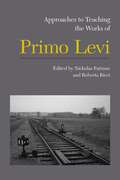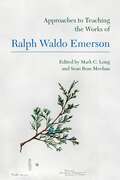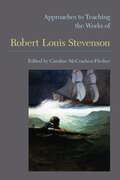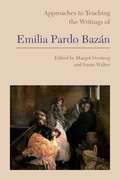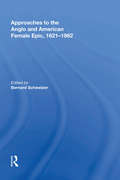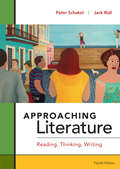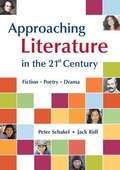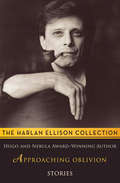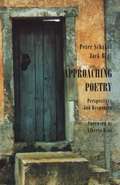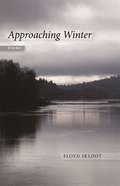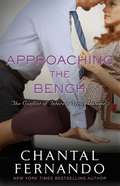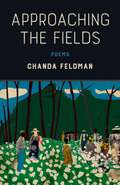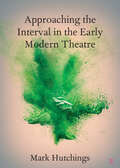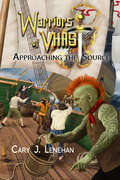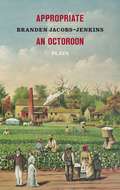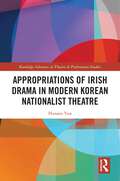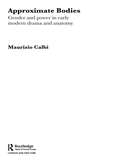- Table View
- List View
Approaches to Teaching the Works of Primo Levi (Approaches to Teaching World Literature #133)
by Nicholas Patruno Roberta RicciPrimo Levi, Holocaust survivor and renowned memoirist, is one of the most widely read writers of post-World War II Italy. His works are characterized by the lean, dispassionate eloquence with which he approaches his experience of incarceration in Auschwitz. His memoirs--as well as his poetry and fiction and his many interviews--are often taught in several fields, including Jewish studies and Holocaust studies, comparative literature, and Italian language and literature, and can enrich the study of history, psychology, and philosophy.The first part of this volume provides instructors with an overview of the available editions, anthologies, and translations of Levi's work and identifies other useful classroom aids, such as films, music, and online resources. In the second part, contributors describe different approaches to teaching Levi's work. Some, in presenting Survival in Auschwitz, The Reawakening, and The Drowned and the Saved, look at the place of style in Holocaust testimony and the reliability of memory in autobiography. Others focus on questions of translation, complicated by the untranslatable in the language and experiences of the concentration camps, or on how Levi incorporates his background as a chemist into his writing, most clearly in The Periodic Table.
Approaches to Teaching the Works of Ralph Ellison (Approaches to Teaching World Literature #177)
by Tracy FloreaniOne of the most important American authors and public intellectuals of the twentieth century, Ralph Ellison had a keen and unsentimental understanding of the relationship between race, art, and activism in American life. He contended with other writers of his day in his examination of the entrenched racism in society, and his writing continues to inform national conversations in letters and culture.The essays in Approaches to Teaching the Works of Ralph Ellison will help instructors in colleges, high schools, and prisons teach not only the indispensable Invisible Man but also Ellison's short stories, his essays, and the two editions of his second, unfinished novel, Juneteenth and Three Days before the Shooting . . . . In considering Ellison's works in relation to jazz, technology, humor, politics, queerness, and disability, this volume mirrors the breadth of Ellison's own life, which extended from the Jim Crow era through the Black Power movement.
Approaches to Teaching the Works of Ralph Waldo Emerson (Approaches to Teaching World Literature #155)
by Mark C. Long and Sean Ross MeehanA leader of the transcendentalist movement and one of the country's first public intellectuals, Ralph Waldo Emerson has been a long-standing presence in American literature courses. Today he is remembered for his essays, but in the nineteenth century he was also known as a poet and orator who engaged with issues such as religion, nature, education, and abolition.This volume presents strategies for placing Emerson in the context of his time, for illuminating his rhetorical techniques, and for tracing his influence into the present day and around the world. Part 1, "Materials," offers guidance for selecting classroom editions and information on Emerson's life, contexts, and reception. Part 2, "Approaches," provides suggestions for teaching Emerson's works in a variety of courses, not only literature but also creative writing, religion, digital humanities, media studies, and environmental studies. The essays in this section address Emerson's most frequently anthologized works, such as Nature and "Self-Reliance," along with other texts including sermons, lectures, journals, and poems.
Approaches to Teaching the Works of Robert Louis Stevenson (Approaches to Teaching World Literature #124)
by Caroline McCracken-FlesherAlthough Robert Louis Stevenson was a late Victorian, his work--especially Treasure Island and The Strange Case of Dr. Jekyll and Mr. Hyde--still circulates energetically and internationally among popular and academic audiences and among young and old. Admired by Henry James, Vladimir Nabokov, and Jorge Luis Borges, Stevenson's fiction crosses the boundaries of genre and challenges narrow definitions of the modern and the postmodern.Part 1 of this volume, "Materials," provides an introduction to the writer's life, a survey of the criticism of his work, and a variety of resources for the instructor. In part 2, "Approaches," thirty essays address such topics as Stevenson's dialogue with James about literature; his verse for children; his Scottish heritage; his wanderlust; his work as gothic fiction, as science fiction, as detective fiction; his critique of imperialism in the South Seas; his usefulness in the creative writing classroom; and how Stevenson encourages expansive thinking across texts, times, places, and lives.
Approaches to Teaching the Writings of Emilia Pardo Bazán (Approaches to Teaching World Literature #147)
by Margot Versteeg Susan Walter"Emilia Pardo Bazán (1851-1921) was the most prolific and influential woman writer of late nineteenth-century Spain," write the editors of this volume in the MLA's Approaches to Teaching World Literature series. Contending with the critical literary, cultural, and social issues of the period, Pardo Bazán's novels, novellas, short stories, essays, plays, travel writing, and cookbooks offer instructors countless opportunities to engage with a variety of critical frameworks. The wide range of topics in the author's works, from fashion to science and technology to gender equality, and the brilliance of her literary style make Pardo Bazán a compelling figure in the classroom.Part 1, "Materials," provides biographical and critical resources, an overview of Pardo Bazán's vast and diverse oeuvre, and a literary-historical time line. It also reviews secondary sources, editions and translations, and digital resources. The twenty-three essays in part 2, "Approaches," explore various issues that are central to teaching Pardo Bazán's works, including the author's engagement with contemporary literary movements, feminism and gender, nation and the late Spanish empire, Spanish and Galician identities, and nineteenth-century scientific and medical discourses. Film adaptations and translations of Pardo Bazán's works are also addressed. Highlighting the artistic, social, and intellectual currents of Pardo Bazán's writings, this volume will assist instructors who wish to teach the author's works in courses on world literature, nineteenth-century literature, and gender studies as well as in Spanish-language courses.
Approaches to the Anglo and American Female Epic, 1621-1982
by Bernard SchweizerEpic has long been regarded as the exclusive domain of the male literary genius and as an incarnation of patriarchal values. This provocative collection of essays challenges such a hegemonic stereotype by demonstrating the ways in which women writers have successfully adapted the masculine epic tradition to suit their own aesthetic needs and to express their own heroic literary, social, and historical visions. Bringing the female epic out of the shadows, the contributors rethink generic boundaries to illuminate this heretofore hidden literary practice. The essays range from Mary Tighe to Rebecca West from Elizabeth Barrett Browning to Gwendolyn Brooks, and from Frances Burney to Virginia Woolf. Bernard Schweizer's introduction, titled 'Muses with Pens,' connects the trajectory of ideas and influences in the individual essays to demonstrate how each participates in reclaiming for women writers a place in the development of a female epic tradition. The volume will be an invaluable resource for scholars working on issues related to genre, canon formation, and the evolution of female literary authority.
Approaching Disappearance
by Anne McconnellMaurice Blanchot (1907-2003), one of the most influential figures of twentieth-century French literature, produced a wide variety of essays and fictions that reflect on the complexities of literary work. His description of writing continually returns to a number of themes, such as solitude, passivity, indifference, anonymity, and absence--forces confronting the writer, but also the reader, the text itself, and the relations between the three. For Blanchot, literature involves a movement toward disappearance, where one risks the loss of self; but such a sacrifice, says Blanchot, is inherent in the act of writing. Approaching Disappearance explores the question of disappearance in Blanchot's critical work and then turns to five narratives that offer a unique reflection on the threat of disappearance and the demands of literature--work by Franz Kafka, Jorge Luis Borges, Louis-René Des Forêts, and Nathalie Sarraute.
Approaching Disappearance
by Anne McconnellMaurice Blanchot (1907-2003), one of the most influential figures of twentieth-century French literature, produced a wide variety of essays and fictions that reflect on the complexities of literary work. His description of writing continually returns to a number of themes, such as solitude, passivity, indifference, anonymity, and absence--forces confronting the writer, but also the reader, the text itself, and the relations between the three. For Blanchot, literature involves a movement toward disappearance, where one risks the loss of self; but such a sacrifice, says Blanchot, is inherent in the act of writing. Approaching Disappearance explores the question of disappearance in Blanchot's critical work and then turns to five narratives that offer a unique reflection on the threat of disappearance and the demands of literature--work by Franz Kafka, Jorge Luis Borges, Louis-René Des Forêts, and Nathalie Sarraute.
Approaching Eye Level
by Vivian GornickFrom an acclaimed feminist writer, essays on “loneliness . . . [the] limitations on friendship and intimacy, [honoring] the process of becoming oneself” (Mary Hawthorne, The New York Times Book Review).Seminal essays on loneliness, living in New York, friendship, feminism, and writing from nonfiction master Vivian Gornick.Vivian Gornick’s Approaching Eye Level is a brave collection of personal essays that finds a quintessentially contemporary woman (urban, single, feminist) trying to observe herself and the world without sentiment, cynicism, or nostalgia. Whether walking along the streets of New York or teaching writing at a university, Gornick is a woman exploring her need for conversation and connection—with men and women, colleagues and strangers. She recalls her stint as a waitress in the Catskills and a failed friendship with an older woman and mentor, and reconsiders her experiences in the feminist movement, while living alone, and in marriage.Turning her trademark sharp eye on herself, Gornick works to see her part in things—how she has both welcomed and avoided contact, and how these attempts at connections have enlivened and, at times, defeated her. First published in 1996, Approaching Eye Level is an unrelentingly honest collection of essays that finds Gornick at her best, reminding us that we can come to know ourselves only by engaging fully with the world.“Gripping.” —Library Journal“Gornick bravely faces—and, even more remarkable, clearly renders—loneliness and the ongoing search for human connection. . . . Her prose is sharp and her characterizations—of her friends, modern life, and of herself—ring true.” —Kirkus Reviews
Approaching Literature (Fourth Edition): Reading, Thinking, Writing
by Jack Ridl Peter SchakelApproaching Literature has been designed to give even reluctant students a comfortable way in to literature. The authors Peter Schakel and Jack Ridl set out to use contemporary literary works as entry points to canonical literature and to make the instruction in reading and writing welcoming and accessible to all students, not just potential English majors. With its affordable price, its streamlined and student-friendly text and its commitment to showcasing the most engaging and diverse literary works publishing right now, all students will find something in Approaching Literature that allows them to experience meaningful immersion into the world of literature.
Approaching Literature in the 21st Century: Fiction, Poetry, Drama
by Jack Ridl Peter SchakelNIMAC-sourced textbook
Approaching Literature: Reading + Thinking + Writing (Third Edition)
by Jack Ridl Peter SchakelThe central aim of this book is to foster habits and skills of critical thinking. The third edition makes the book even more inclusive and accessible than the first and second editions. A unique feature of this book is its appendix on reading critical essays, which provides practical instruction on how to approach and read the academic essay, a genre that in itself is unfamiliar to many students, and which students may be asked to use as sources in their own writing.
Approaching Oblivion: Road Signs on the Treadmill Toward Tomorrow
by Harlan EllisonThe New York Times called him "relentlessly honest" and then used him as the subject of its famous Sunday Acrostic. People Magizine said there was no one like him, then cursed him for preventing easy sleep. But in these stories Harlan Ellison outdoes himself, rampaging like a mad thing through love ("Cold Friend", "Kiss of Fire", "Paulie Charmed the Sleeping Woman"), hate ("Knox", "Silent in Gehenna"), sex ("Catman", "Erotophobia"), lost childhood ("One Life, Furnished in Early Poverty") and into such bizarre subjects as the problems of blue-skinned, eleven-armed Yiddish aliens, what it's like to witness the end of the world and what happens on the day the planet Earth swallows Barbra Streisand. Oh yeah, this one's a doozy!
Approaching Oblivion: Stories
by Harlan EllisonOver the course of his legendary career, Harlan Ellison has defied--and sometimes defined--modern fantasy literature, all while refusing to allow any genre to claim him. A Grand Master of the Science Fiction Writers of America, winner of the Lifetime Achievement Award from the Horror Writers Association, as well as winner of countless awards, including the Hugo, Nebula, Edgar Allan Poe, and Bram Stoker, Ellison is as unpredictable as he is unique, irrepressible as he is infuriating. Over thirty titles in Ellison's brilliant catalog are now available in an elegant new package featuring Ellison himself. Genius never felt so combustible. The New York Times called him "relentlessly honest" and then used him as the subject of its famous Sunday Acrostic. People said there was no one like him, then cursed him for preventing easy sleep. But in these stories, Harlan Ellison outdoes himself, rampaging like a mad thing through love ("Cold Friend," "Kiss of Fire," "Paulie Charmed the Sleeping Woman"), hate ("Knox," "Silent in Gehenna"), sex ("Catman," "Erotophobia"), lost childhood ("One Life, Furnished in Early Poverty"), and into such bizarre subjects as the problems of blue-skinned, eleven-armed Yiddish aliens, what it is like to witness the end of the world, and what happens on the day the planet Earth swallows Barbra Streisand. Oh yeah, this one is a doozy!
Approaching Poetry: Perspectives and Responses
by Jack Ridl Peter SchakelThis wide-ranging introduction to poetry blends theoretical considerations with a thorough introduction to the elements of poetry, offering alternative perspectives from which to approach and engage with a poem.
Approaching Winter: Poems
by Floyd SklootFloyd Skloot's eighth poetry collection, Approaching Winter, evokes the fluid and dynamic nature of memory as it ebbs and floods through our daily lives. Here the real and the imagined intermingle freely: In one poem, the cry of eagles reflects the wails of an infant daughter, long since grown and gone; in another, an aging Samuel Beckett prepares to throw the first pitch at Ebbets Field. Traveling from Portland's Willamette River, which borders Skloot's home, to the hushed landscapes of the afterlife, the poems in this collection acknowledge the passage of time and the inevitable darkness that lies ahead. Yet Skloot also remains attuned to the urgency of the present moment, as he admires the plumage of the local birds in the short days before their journey south for the winter. By turns whimsical and meditative, Approaching Winter gives voice to the struggle to find coherence in a fragmented world.
Approaching the Bench (The Conflict of Interest Series #3)
by Chantal FernandoA tenacious, resilient female judge must find a way to work with her carefree clerk as they find themselves in danger when a fugitive sets his sights on revenge in the third book in New York Times bestselling author Chantal Fernando’s sexy and thrilling Conflict of Interest Series.Trinity Williams, known as “Medusa” for her stony expressions and unyielding reputation, constantly has her guard up—how else is the youngest female judge in the country supposed to survive in such a male-dominated profession? She made the decision long ago that laughter and a carefree attitude have no business in a courtroom and achieving her professional goals is the only thing she has left. It’s just her luck that her new law clerk, Callum Hopkins, believes the exact opposite. Callum Hopkins thinks that nothing should ever be too serious in life—why can’t he mix business with pleasure? When he first starts working for his hot new boss, they clash at every turn. He makes it his mission to get Judge Williams to see things his way for once. But when Callum finds himself in the wrong place at the wrong time as an escaped convict comes after Trinity, he realizes it’s not all fun and games anymore. Now in witness protection together until the authorities can catch the fugitive, this unlikely pair must learn to trust one another and work together to stay alive. Far away from the courtroom, Trinity and Callum are suddenly free to stop butting heads, and stop fighting the growing attraction between them. With suspense and plenty of chemistry, Approaching the Bench proves once again that “Chantal Fernando knows how to draw you in and keep you hooked” (Booklist).
Approaching the Fields: Poems
by Chanda FeldmanElegiac and fierce, solemn and celebratory, the poems in Chanda Feldman’s Approaching the Fields consider family and history. From black sharecroppers and subsistence farmers along the Mississippi River to contemporary life in the suburbs, the rituals of home and work link racial experience, social lines, and economic striving, rooting memory and scene in the southern landscape. Love and violence echo through the collection, and Feldman’s beautifully crafted poems, often formal in style, answer them sometimes with an embrace and sometimes with a turning away. She witnesses the crop fields and manicured lawns, the dinner table and birthing room, the church and juke joint, conveying the ways that everyday details help build a life.These evocative poems bring to life a rich and complex world, both timely and timeless.
Approaching the Interval in the Early Modern Theatre: The Significance of the 'Act-Time' (Elements in Shakespeare Performance)
by Mark HutchingsIn requiring artificial light, the early modern indoor theatre had to interrupt the action so that the candles could be attended to, if necessary. The origin of the five-act, four-interval play was not classical drama but candle technology. This Element explores the implications of this aspect of playmaking. Drawing on evidence in surviving texts it explores how the interval affected composition and stagecraft, how it provided opportunities for stage-sitters, and how amphitheatre plays were converted for indoor performance (and vice versa). Recovering the interval yields new insights into familiar texts and brings into the foreground interesting examples of how the interval functioned in lesser-known plays. This Element concludes with a discussion of how this aspect of theatre might feed into the debate over the King's Men's repertory management in its Globe-Blackfriars years and sets out the wider implications for both the modern theatre and the academy.
Approaching the Source (Warriors of Vhast)
by Cary LenehanApproaching the Source continues to follow the battle of good and evil in an ongoing story on the distant and artificial world of Vhast. The people who find themselves in the formerly hidden village of Mousehole begin to find out where their enemy, the Adversaries, are based. Instead of reacting to them, they begin to learn more about them and take them on in their own strongholds.Following on from Intimations of Evil, and the next five books of the series, the Princess, and her wife the mage, the Cat, the priest, the ghazi, and the many others, including free and former slaves, begin to strike out and discover how much they have grown and how they can confound an enemy that has plagued Vhast for thousands of years.Approaching the Source is the seventh and penultimate book of a series where magic is a scientific experiment. Good struggles with evil to control this magic in a world made by an alien race for their own purposes.
Appropriate/An Octoroon: Plays
by Branden Jacobs-Jenkins<p>A double-volume containing two astonishing breakout plays from one of the theatre's most exciting and provocative young writers. <p>In Appropriate, strained familial dynamics collide with a tense undercurrent of socio-political realities when the Lafayettes gather at a former plantation home to sift through the belongings of their deceased patriarch. An Octoroon is an audacious investigation of theatre and identity, wherein an old play gives way to a startlingly original piece. <p>Also includes the short play I Promise Never Again to Write Plays About Asians...</p>
Appropriate: A Provocation
by Paisley RekdalA timely, nuanced work that dissects the thorny debate around cultural appropriation and the literary imagination. How do we properly define cultural appropriation, and is it always wrong? If we can write in the voice of another, should we? And if so, what questions do we need to consider first? In Appropriate, creative writing professor Paisley Rekdal addresses a young writer to delineate how the idea of cultural appropriation has evolved—and perhaps calcified—in our political climate. What follows is a penetrating exploration of fluctuating literary power and authorial privilege, about whiteness and what we really mean by the term empathy, that examines writers from William Styron to Peter Ho Davies to Jeanine Cummins. Lucid, reflective, and astute, Appropriate presents a generous new framework for one of the most controversial subjects in contemporary literature.
Appropriations of Irish Drama in Modern Korean Nationalist Theatre (Routledge Advances in Theatre & Performance Studies)
by Hunam YunThis book investigates the translation field as a hybrid space for the competing claims between the colonisers and the colonised. By tracing the process of the importation and appropriation of Irish drama in colonial Korea, this study shows how the intervention of the competing agents – both the colonisers and the colonised – formulates the strategies of representation or empowerment in the rival claims of the translation field. This exploration will be of great interest to students and scholars of theatre and performance studies, translation studies, and Asian studies.
Approximate Bodies: Gender and Power in Early Modern Drama and Anatomy
by Maurizio CalbiThe early modern period was an age of anatomical exploration and revelation, with new discoveries capturing the imagination not only of scientists but also of playwrights and poets. Approximate Bodies examines, in fascinating detail, the changing representation of the body in early modern drama and in the period's anatomical and gynaecological treatises. Maurizio Calbi focuses on the unstable representation of both masculinity and femininity in Renaissance texts such as The Duchess of Malfi, The Changeling and a variety of Shakespeare plays. Drawing on theorists including Foucault, Derrida and Lacan, these close textual readings examine the effects of social, psychic and cultural influences on early modern images of the body. Calbi identifies the ways in which political, social, racial and sexual power structures effect the construction of the body in dramatic and anatomical texts. Calbi's analysis displays how images such as the deformed body of the outsider, the effeminate body of the desiring male and the disfigured body parts of the desiring female indicate an unstable, incomplete conception of the body in the Renaissance. Compelling and impeccably researched, this is a sophisticated account of the fantasies and anxieties that play a role in constructing the early modern body. Approximate Bodies makes a major contribution to the field of early modern studies and to debates around the body.
Approximate Gestures: Infinite Spaces in the Fiction of Percival Everett
by Anthony StewartIn Approximate Gestures, Anthony Stewart argues that the writing of Percival Everett, the acclaimed author of Erasure and more than twenty other works of fiction, compels readers to retrain their thinking habits and to value uncertainty. Stewart maintains that Everett’s fiction challenges its interpreters to question their assumptions, consider the spaces in between categories, and embrace the potential of a larger, more uncertain world in an effort to confront bigotry and similarly limiting patterns of thought. Drawing on the work of Gilles Deleuze and Félix Guattari, Stewart proposes that their notion of the schizorevolutionary figure captures the in-between status of many of Everett’s characters as they refuse the constraints of the binary, categorical structures that govern so much of human life. Approximate Gestures engages specifically with the vexed question of discussing race in Everett’s fiction. Stewart frames the stakes of analyzing such subject matter in the writing of an African American novelist whose work rigorously questions critical approaches to race. Requiring readers to engage with black males who are hydrologists, ranchers, college professors, romance novelists, and in one case, a toddler, means entering a world released from habitual frames of reference. Through an examination of a broad selection of novels, Stewart demonstrates the extent to which Everett’s characters inhabit “infinite spaces in between conventional categories” and understand themselves as subjects attempting to navigate social and psychological worlds. Approximate Gestures: Infinite Spaces in the Fiction of Percival Everett encourages readers and critics to think more deeply about how they position themselves in and engage with the world around them. As one of the first books of literary criticism devoted to Everett’s fiction, Stewart’s pathbreaking study models a method for reading the formidable body of work being produced by a major contemporary writer.
